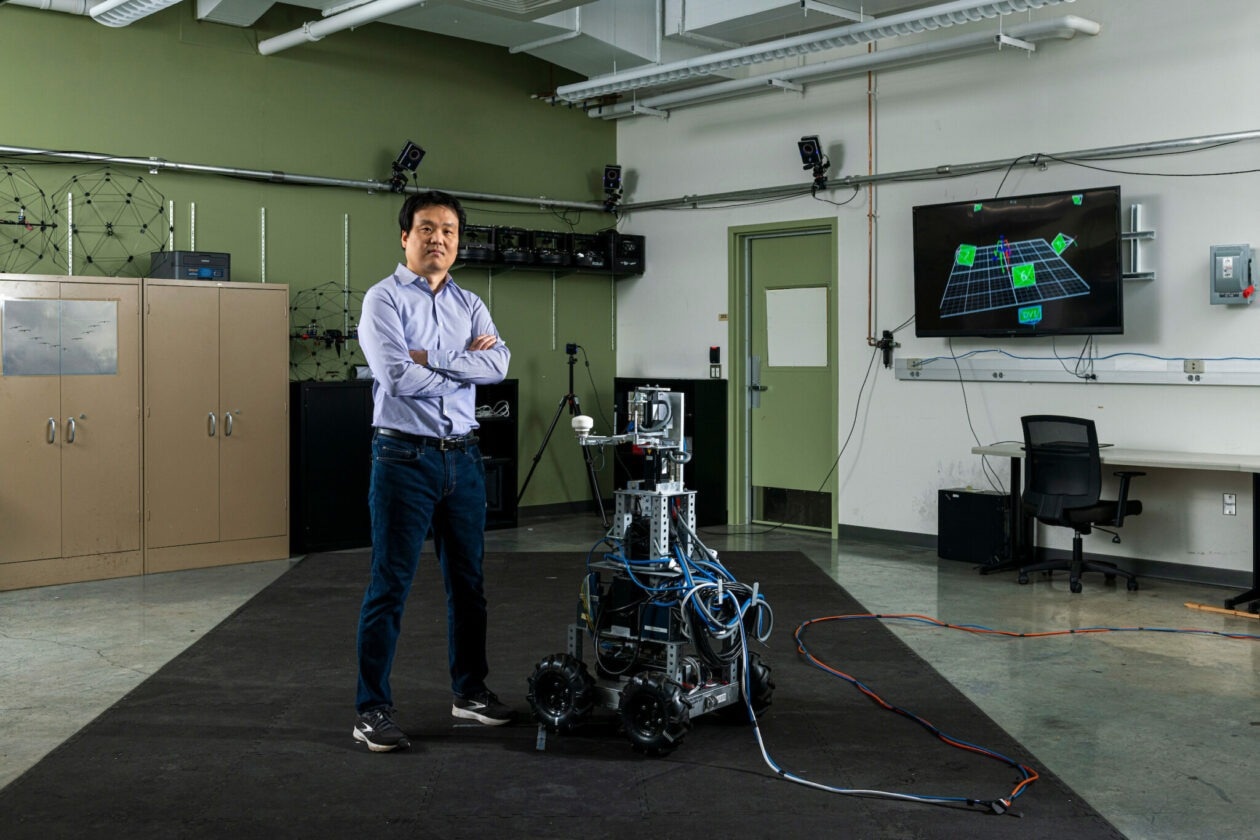Reviewed by Emily Henderson, B.Sc.Nov 11 2022
Researchers at Missouri University of Science and Technology (Missouri S&T) illustrate in a new study how human participants, walking hand-in-hand with a robot guide, tend to relax or stiffen their arms at various times during the walk.
 Dr. Yun Seong Song, assistant mechanical and aerospace engineering professor at Missouri S&T, with his interactive robot Ophrie. Image Credit: Mike Pierce, Missouri University of Science and Technology.
Dr. Yun Seong Song, assistant mechanical and aerospace engineering professor at Missouri S&T, with his interactive robot Ophrie. Image Credit: Mike Pierce, Missouri University of Science and Technology.
The analysis of these movements carried out by the researchers could help develop smarter, more humanlike robot assistants and guides.
“This work presents the first measurement and analysis of human arm stiffness during overground physical interaction between a robot leader and a human follower,” the Missouri S&T scientists write in an article recently published in the Nature journal Scientific Reports.
An early step in developing a robot that is humanlike when it physically interacts with a human partner. This is related to the idea of having assistive robots that can seamlessly interact with us.
Dr. Yun Seong Song, Study Lead Researcher and Assistant Professor of Mechanical and Aerospace Engineering, Missouri University of Science and Technology
Humans often interact with each other without using verbal communication or even visual signs when carrying out some tasks, such as when a couple dances the waltz or when an individual helps another walk.
In their Scientific Reports article, the team illustrates the underlying forces when a robotic guide strides with humans along three diverse trajectories.
“At first glance, physical interaction is a dynamic task with power exchanges dictated by the passive properties of the interacting being,” Song says.
But if you examine how humans handle physical interaction, you realize that there must be constant information processing and decision-making to infer each other’s intent. Uncovering the mechanism through which this happens will help us design future robots that can seamlessly interact with their human partners.
Dr Yun Seong Song, Study Lead Researcher and Assistant Professor of Mechanical and Aerospace Engineering, Missouri University of Science and Technology
“Even without explicitly shared goals, two human partners can physically interact with each other to perform collaborative tasks,” write Song and his fellow Missouri S&T scientists, Dr. Devin Burns, associate professor of psychological science, and Dr. Sambad Regmi, who earned a Ph.D. from S&T in May 2022. Burns helped design the experiment and “rigorously interpreted the data” while co-mentoring Regmi, Song says.
Using Ophrie, their newly built interactive robot, the team replicated a guided walking task that needed the human participants to close their eyes while catching the handle on the robot’s arm.
Ophrie—an acronym for Overground Physical Human-Robot Interaction—was taught to travel on a straight trajectory for the first 1.5 m of the walk (approximately 5 feet), then digress either to the right or left or continue the straight trajectory. The participants were supposed to react to haptic signals transmitted via the handle to perceive the movement of the robot.
The S&T scientists assessed the stiffness of the arm at two points during the walk: either when the robot could choose one of three different trajectories, at which point the human participants were less sure of the route, or at the end of the walk, when participants were more sure of the robot’s route.
“We observed that the arm stiffness was lower at instants when the robot’s upcoming trajectory was unknown compared to instants when it was predictable,” the researchers write. This presents “the first evidence of arm stiffness modulation for better motor communication during overground physical interaction.”
The experiments had 10 human participants in their mid-20s. Nine of the 10 were male, one was left-handed, and none of them had any neurological complaints.
Comprehending this interaction between robots and humans can result in enhancements in robot design, Song explains. An interactive robot assistant could be used in the care of the elderly, physical therapy, and other domains.
“Like a human partner, these robots would help a construction worker carry loads or an elderly person with mobility issues walk from the bedroom to the kitchen,” Song says.
We want these robots to be effective in their performance, intuitive to use and communicate with, and safe to interact with, all while maintaining physical contact with their human partners.
Dr Yun Seong Song, Study Lead Researcher and Assistant Professor of Mechanical and Aerospace Engineering, Missouri University of Science and Technology
In 2021, Song was the recipient of a Faculty Early Career Development (CAREER) Award from the National Science Foundation to aid his research to improve the physical interaction between humans and robots.
Journal Reference:
Regmi, S., et al. (2022) Humans modulate arm stiffness to facilitate motor communication during overground physical human-robot interaction. Scientific Reports. doi.org/10.1038/s41598-022-23496-z.